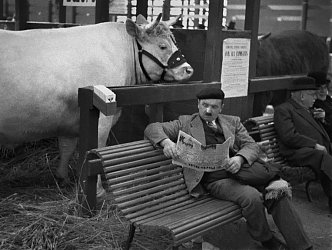André Kertész (born Kertész Andor July 2, 1894 - September 28, 1985) was a Hungarian-born photographer distinguished by haunting composition in his photographs and by his early efforts in developing the photo essay. In his lifetime, however, his then-unorthodox camera angles, which hindered prose descriptions of his works, prevented his work from gaining wider recognition. His use of symbolism also became unfashionable later in his life. Kertész is now recognized as one of the seminal figures of photojournalism.
Born in Budapest, the son of a bookseller, Kertész taught himself how to use a camera and had his first photos published while a member of the Austro-Hungarian army during World War I. Even as early as 1914 (e.g. "Eugene, 1914") his distinctive and mature style was already evident.

Kertész emigrated to Paris in 1925, changed his first name from Andor, and became acquainted with members of the Dada movement. One of them dubbed him "Brother Seeing Eye", an allusion to a medieval monastery where all the monks were blind except one. His greatest journalistic collaboration was with the French editor and publisher Lucien Vogel, who ran his photographs without explanatory prose. He created portraits of (among others) the painters Mondrian and Marc Chagall, the writer Colette, and film-maker Sergei Eisenstein. In Paris he found critical and commercial success, and he was the first photographer in the world ever to have a one-man exhibition (1927). He was a mentor to many famous names in photography; Henri Cartier-Bresson said, "We all owe something to Kertész".
In 1936 Kertész and his wife Erzsebet (later altered to Elizabeth) went to the United States to escape the increasing tension in Europe that was leading to World War II. The Condé Nast Publishing empire had signed Kertész to a long-term contract, which meant he spent most of his time photographing famous homes for House & Garden magazine. However, his personal photographic style did not mesh well with the straightforward fashion photography the American public (and magazines) expected. He continued to exhibit his individual work as best he could but his reputation slowly faded, and he became disillusioned.

His work did not appear in Steichen's famous The Family of Man show at the Museum of Modern Art, but in 1964, soon after John Szarkowski became the photography director at the museum, Kertész had a solo show which relaunched his career and reputation. He caught the mood of the times and became something of an elder statesman to the photographers of the late 1960s and early 1970s. They had been seeking to validate a tradition of documentary/art photography through linking it back to the Paris photographers of the 1920s and 1930s.
By the mid-1970s he was showing his work in galleries all over the world. He continued working very productively into old age, and was experimenting with instant Polaroid photography shortly before he died.
LINK


Sem comentários:
Enviar um comentário